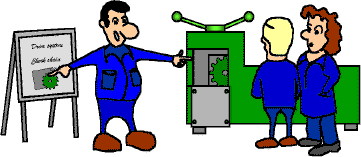Total Productive Maintenance (TPM) Approach
|
Total Productive Maintenance (TPM) Approach |
|
|
TPM
is a facility / equipment based approach to assuring and improving
processes. It is most appropriate in a continuous process, such as an oil
refinery, where many of the typical inherent problems which JIT overcomes
are not found. Capital and material costs by far outweigh labour costs.
Nevertheless, we are reliant on our people to maintain and improve methods
and systems, so TQC is often a precursor to TPM.
With JIT, we are seeking to emulate continuous flow processes, so it becomes increasingly important that our equipment is capable and reliable, so many manufacturing companies are adopting TPM. |
| . In its broadest sense, TPM is applied to the whole working environment - procedures, standards, workplace, training and education, logistics, administration, etc. - for we want the best from these, just as we do from our equipment. It encompasses everything from routine cleaning of the workplace to what is currently becoming known a 'asset management'. | |
|
Traditional
'maintenance' is not good enough in today's markets.
Applying Total Productive Maintenance techniques ensures enhanced productivity
through reduced cycle times, improved equipment capability - tighter
tolerances and better material yields - reducing the time required for
maintenance, and possibly increasing the range of the equipment’s
activities. These gains are normally quantified using O.E.E.
(Overall Equipment Effectiveness)
as a measure which highlights availability,
utilisation and the
quality performance of equipment.
A starting point for practical TPM activity is 5C (from the Japanese 5S) |
|
|
|
1. Clearout The first step is to decide what is needed and what is not needed to do the job - and get rid of the latter! This avoids having to work around clutter and waste time rummaging through redundant tools, materials & information. |
|
|
2. Configure Determine the most convenient place to keep things in, make it clear what is what and where it belongs. This avoids time wasted seeking things out. 'A place for everything, and everything in its place!' |
|
|
3. Clean & Check We now need to take a close look at the condition of what we've got. The act of cleaning enforces scrutiny, so that actual and potential problems can be spotted and rectified before they result in equipment failure. This gets TPM started. |
 |
4. Conformity We don't want to lose what we've gained, so we need to establish procedures for maintenance: routinely monitoring condition; cleaning; lubricating; tightening; etc. Also set standards for operating and setting equipment, changing tools, etc. |
|
|
5. Custom & Practice Maintain the disciplines of the 5Cs whilst striving for better performance. Get more out of the facilities for less expenditure; develop peoples' skills in different areas of maintenance. |
 |
|
|
The web site dedicated to improving manufacturing competitiveness |
|
|
genba-kanri.com |